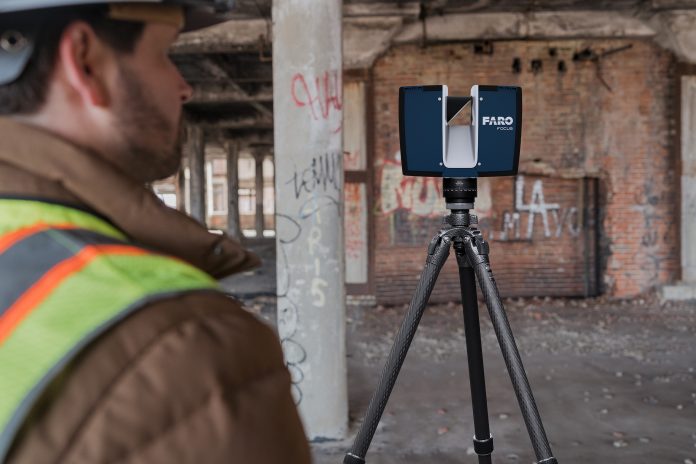Choosing the right reality capture technology for architecture, engineering, and construction professionals can be a challenging task in today’s uncertain economic climate
If there’s one adage that applies to meteorologists and economists alike, it’s that they are both professions where you can be wrong 50% of the time and still keep your job. Just ask the retired BBC weatherman Michael Fish.
The truth is that economists and BBC weathermen alike are in a difficult business. Predicting the future is not easy. And neither is making the downstream decisions that come from that data — whether, in Michael Fish’s case, it was knowing if a hurricane was coming for the South of England in October 1987 (it wasn’t, but it still proved to be one of the UK’s deadliest natural disasters) — or if you’re in the market for 3D scanners and related reality capture technology.
In our current moment, the winds of economic change appear to be blowing in opposite directions. Fair weather prognosticators are calling for continued good times ahead — the Confederation of British Industry (CBI) is forecasting 0.4% GDP growth in 2023, growing to 1.8% in 2024, while others are calling for stronger gales and a possible recession. With uncertainty the only certainty, How does an architecture, engineering and construction professional budget for a reality capture device?
A focus on core beliefs
The answer begins with remembering three simple rules:
- Economic expansions and contractions should not be the sole metric from which
to make a business decision like purchasing a 3D laser scanner or related reality capture equipment. - When it comes to modern reality capture technology, there really is no one size (or one price point) to fit all.
- Don’t let perfection be the enemy of the good. Said another way: Sometimes good enough is good enough. More on that later.
Regarding the first point, timeworn logic suggests that recessions are about belt-tightening.
After all, a top-of-the-line laser scanner could cost thousands. Why spend a pretty pound if construction projects are going to dry up?
But trepidation over the initial expense overlooks the fact that these devices, whatever the cost, low or high, will likely be offset over time. In fact, estimates place industrial site project compression at 10%, with total project cost reductions at 7%. No recession lasts forever (most end within six to 18 months), and planning for a likely post-recession rebound is never a bad decision.
Then there’s that “no one size fits all” truism. While the phrase “3D reality capture” might instil fears of bank-busting expense, the truth is more nuanced. Reality capture technology today exists in a burgeoning marketplace filled with devices on a continuum of increasing speed, accuracy, portability — and price.
At FARO, a global leader in 3D measurement, imaging and realisation solutions for AEC professionals, the FARO Focus Core Laser Scanner, for example, provides the ideal combination of price and performance, featuring colorised scan speeds of less than one minute per scan and up to a 70m scanning range.
Low-cost entry into laser scanning can take other forms, too. In the last decade, mobile mapping has advanced considerably. And while they can achieve up to the 6mm accuracy range (far below a static scanner) very often, for the right applications, the data granularity is good enough to get the job done. Again, don’t let perfection be the enemy of the good.
With its acquisition of UK-based GeoSLAM, a leading provider of mobile scanning solutions with proprietary high-productivity simultaneous localisation and mapping (SLAM) software to create 3D models for use in digital twin applications, FARO is well-positioned to offer cost-competitive geolocation solutions.
Mobile mapping enables the ability to collect geospatial data on the go — without the need for GPS. Thanks to this revolutionary technology, some of the world’s most hard-to-reach places indoors, outdoors and underground can now be accessed, mapped, measured and shared.
Of course, reality-capture technology would be incomplete without mention of 360°
photogrammetry (using photography in surveying and mapping to measure
distances between objects) and its attendant software. This, too, is another cost-competitive entry in the reality capture market and is ideal for construction project management, as-built documentation, issue management and operations and maintenance.
Reality capture done right: Whatever the economic forecast
On October 15, 1987, BBC weatherman Michael Fish delivered his infamous broadcast: “Earlier today, apparently, a woman rang the BBC and said she heard there was a hurricane on the way… well, if you’re watching, don’t worry, there isn’t!”
While there was, in fact, no hurricane, a powerful storm did impact the British Isles,
with winds gusting past 100mph in the South East, killing 18 people, downing some 15m trees and causing £2bn in damages.
The lesson from the story is clear. Data can mislead. Even the best data gathered from
the most advanced, expensive technology can paint an incomplete (or overly complex) picture of the facts on the ground, leading to flawed conclusions.
Had Mr Fish relied on other, less sophisticated technologies, say, for instance, visual reports from commercial shipping vessels in the Bay of Biscay and the English Channel or from callers calling into the BBC to report high winds in Shoreham on the Sussex coast, rather than images from the Meteosat-2 satellite, he might have adjusted his forecast or tweaked the urgency of his language.
For him, good enough data could have come from lower-cost alternatives — with better results. For AEC professionals looking to dip their toes into the reality capture space, the desire to buy the most accurate, most expensive hardware and software should be tempered with a detailed understanding of your most reasonable project needs and those
of your customers.
Low cost does not mean low quality. And the right tool for the right job (at the right price) is always the best advice, regardless of the ever-turbulent economic — or maritime — seas.
Amanda Hidalgo
Office of Corporate Communications
FARO Technologies
Tel: +1 700-161-1036
*Please note: This is a commercial profile.

















